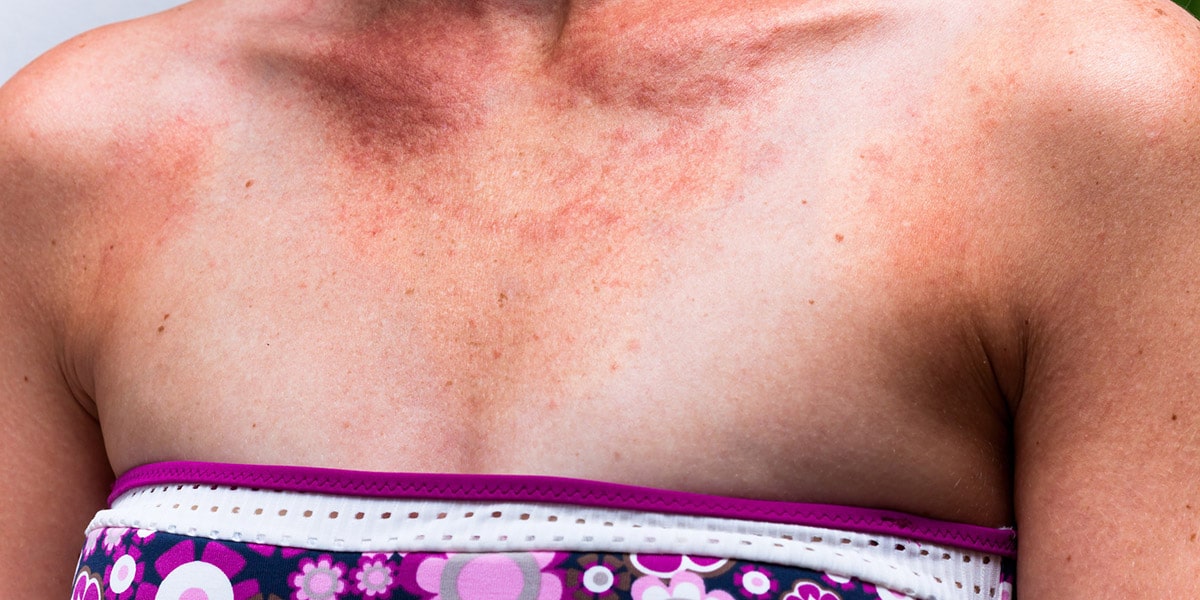When you come inside after spending time in the sun, you may notice your skin has become inflamed and itchy in the areas that were exposed to the sun. Or maybe after being outside for just a few minutes, your skin starts to break out in hives. You could be suffering from a sun allergy.
What is an allergic reaction? And is it really possible to be allergic to the sun? Allergic reactions happen because of your immune system. It’s made of cells that patrol your body, looking for signs of danger¹. Substances that your body identifies as dangerous are referred to as allergens. When immune cells encounter an allergen, molecules called antibodies are produced. They cause the release of chemicals, leading to symptoms like itching, inflammation, and the like. Each type of these antibodies only recognizes a single allergen, meaning our allergies depend on which types of antibodies we have. This is why you and your friends may have different allergies².
The clinical term for a sun allergy is photosensitivity. Unlike sunburns, there is no correlation between skin type and sun allergy predisposition³. Also, sun allergy does not involve DNA damage whereas sunburns do⁴. Allergic reactions to the sun can be spontaneous, or they can be influenced by drug or chemical exposure. Photosensitivity can also come along with diseases like lupus⁵.Solar urticaria is a type of sun allergy where individuals experience hives after exposing their skin to the sun⁵. The hives usually last 30 minutes to 2 hours, and they return with repeated sun exposure⁶. Scientists aren’t quite sure of what causes the reaction, however, they suspect that it’s due to naturally occurring photoallergens in the skin⁵. Polymorphous light eruption (PMLE) is another type of sun allergy. It takes the form of red, itchy bumps, appearing 30 minutes to several hours after exposing skin to the sun. The bumps usually disappear within days to weeks, and with repeat episodes, the severity of the reactions can decrease. PMLE is most commonly experienced by women and individuals from northern climates at the beginning of the summer season⁷.
Chemical photosensitivity occurs when drugs or chemicals cause adverse skin reactions when exposed to the sun. The reactions can resemble a sunburn or a bumpy rash. Phototoxicity occurs when a drug or chemical absorbs sunlight and produces compounds that cause inflammation. Photoallergic reactions, on the other hand, occur when sunlight turns a substance into an allergen⁵. Phototoxicity is more common than photoallergy, and it can cause long-term damage to the skin⁸. Scientists know of many drugs, both oral and topical, that cause chemical photosensitivity, including ones used to treat acne, bacterial infections, and depression⁵. Click here to see if the drug you’re taking is on the list.
In order to avoid sun allergy, wear a broad-spectrum sunscreen to protect yourself from dangerous UV radiation. Also, be sure to ask your physician or pharmacist if the drug you’ve been prescribed can cause photosensitivity. If so, take extra sun-safety precautions while you’re using the drug.The Latest Tech To Avoid Sun Allergies
In order to avoid sun allergy, wear a broad-spectrum sunscreen, protective clothing, and know how much time to spend in the sun to protect yourself from dangerous UV radiation. It can be confusing to manage all these factors in your head but by using the latest technology like Sun Index, you can free your mind of worries. Sun Index, can take into account your skin type and clothing to give personalized daily sun-safety recommendations such as how much sunscreen to apply and when to reapply it.
Sources:
- American Academy of Allergy Asthma & Immunology. (n.d.). Immune System. Retrieved July 4, 2016
- American Academy of Allergy Asthma & Immunology. (n.d.). Allergic Reactions. Retrieved July 4, 2016
- Neporent, L. (2013). Sunlight Allergies May Affect up to 20 Percent of the World’s Population. Retrieved July 4, 2016
- Hadhazy, A. (2011). Anatomy of a Sunburn: A Timeline of Dermatological Destruction. Retrieved July 4, 2016
- MacNeal, R. J. (2014). Photosensitivity. Retrieved July 4, 2016
- Drugs.com. (n.d.). Sun Allergy (Photosensitivity). Retrieved July 4, 2016
- MacNeal, R. J. (n.d.). Photosensitivity Reactions. Retrieved July 4, 2016
- Skin Cancer Foundation. (n.d.). Phototoxic Reactions versus Photoallergic Reactions. Retrieved July 4, 2016



